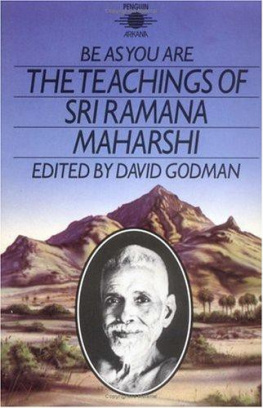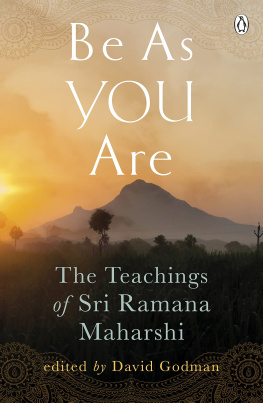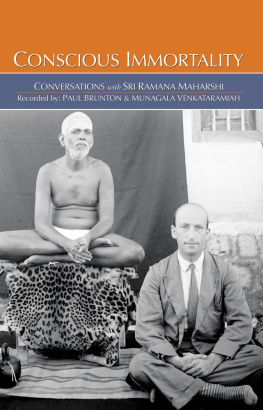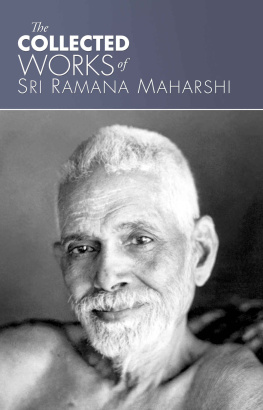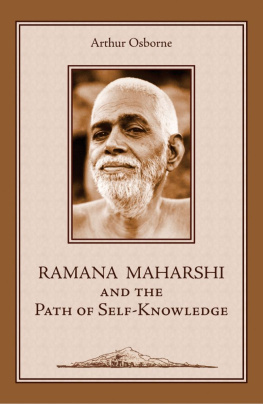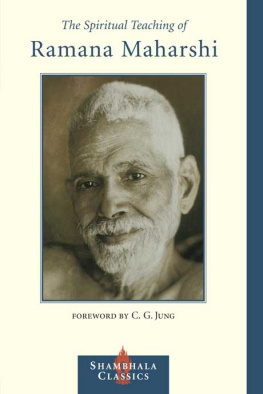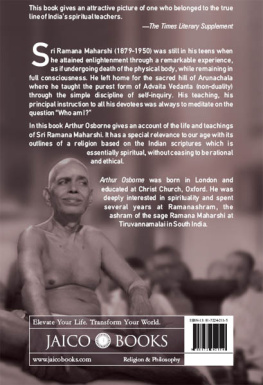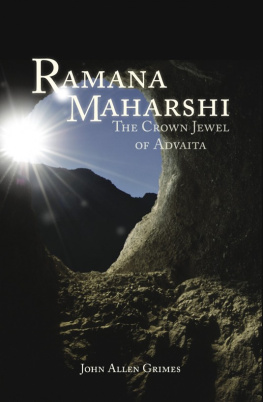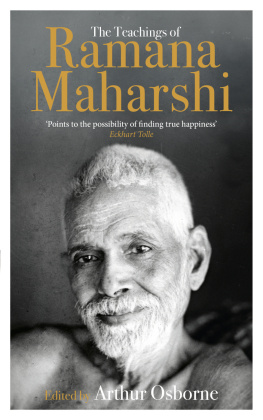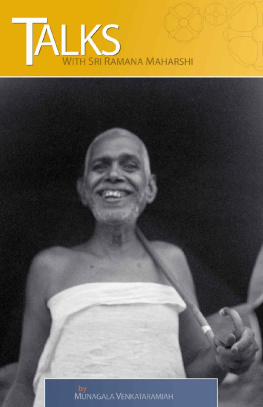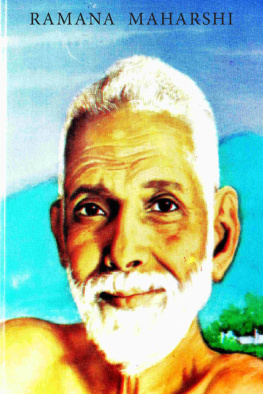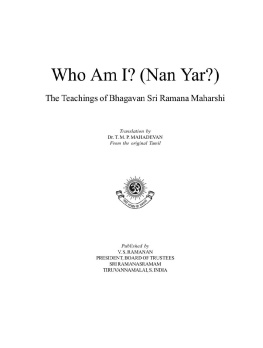Be As You Are
The Teachings of Sri Ramana Maharshi
Edited by David Godman
Published by the Penguin Group
Penguin Books Ltd, 80 Strand, London WC2R ORL, England Penguin Putnam Inc., 375 Hudson Street, New York, New York 10014, USA Penguin Books Australia Ltd, 250 Camberwell Road, Camberwell, Victoria 3124, Australia Penguin Books Canada Ltd, 10 Alcorn Avenue, Toronto, Ontario, Canada M4V 3B2 Penguin Books India (I) Ltd, 11 Community Centre, Panchsheel Park, New Delhi 110 017, India Penguin Books (NZ) Ltd, Cnr Rosedale and Airborne Roads, Albany, Auckland, New Zealand Penguin Books (South Africa) (Pty) Ltd, 24 Sturdee Avenue, Rosebank 2196, South Africa Penguin Books Ltd, Registered Offices: 80 Strand, London WC2R ORL, England
www.penguin.com
First published by Arkana 1985
Copyright Sri Ramanasramam, 1985 All rights reserved Printed in England by Clays Ltd, St Ives plc Except in the United States of America, this book is sold subject to the condition that it shall not, by way of trade or otherwise, be lent, re-sold, hired out, or otherwise circulated without the publishers prior consent in any form of binding or cover other than that in which it is published and without a similar condition including this condition being imposed on the subsequent purchaser
Contents
PART ONE - The Self...7
PART TWO - Enquiry and surrender...28
PART THREE - The Guru...55
PART FOUR - Meditation and yoga... 68
PART FIVE - Experience...91
PART SIX - Theory...106
Acknowledgments
To Sri Ramanasramam for permission to reprint extracts from most of the books listed in the bibliography.
To Rider and Co., London, for permission to reprint an extract from A Search in Secret India.
To Sadhu Om, for permission to reprint material from The Path of Sri Ramana and for permission to use and adapt his unpublished translations of the writings of Sri Ramana Maharshi and Guru Vachaka Kovai.
To Michael James for assistance in adapting verses from Guru Vachaka Kovai and for offering constructive advice throughout the preparation of the book.
Introduction
In 1896 a sixteen-year-old schoolboy walked out on his family and, driven by an inner compulsion, slowly made his way to Arunachala, a holy mountain and pilgrimage centre in South India. On his arrival he threw away all his money and possessions and abandoned himself to a newly-discovered awareness that his real nature was formless, immanent consciousness. His absorption in this awareness was so intense that he was completely oblivious of his body and the world; insects chewed away portions of his legs, his body wasted away because he was rarely conscious enough to eat and his hair and fingernails grew to unmanageable lengths. After two or three years in this state he began a slow return to physical normality, a process that was not finally completed for several years. His awareness of himself as consciousness was unaffected by this physical transition and it remained continuous and undimmed for the rest of his life. In Hindu parlance he had realised the Self; that is to say, he had realised by direct experience that nothing existed apart from an indivisible and universal consciousness which was experienced in its unmanifest form as beingness or awareness and in its manifest form as the appearance of the universe.
Normally this awareness is only generated after a long and arduous period of spiritual practice but in this case it happened spontaneously, without prior effort or desire. Venkataraman, the sixteen-year-old schoolboy, was alone in an upstairs room of his uncles house in Madurai (near the southern tip of India) when he was suddenly gripped by an intense fear of death. In the following few minutes he went through a simulated death experience during which he became consciously aware for the first time that his real nature was imperishable and that it was unrelated to the body, the mind or the personality. Many people have reported similar unexpected experiences but they are almost invariably temporary. In Venkataramans case the experience was permanent and irreversible. From that time on his consciousness of being an individual person ceased to exist and it never functioned in him again.
Venkataraman told no one about his experience and for six weeks he kept up the appearance of being an ordinary schoolboy. However, he found it an increasingly difficult posture to maintain and at the end of this six week period he abandoned his family and went directly to the holy mountain of Arunachala.
The choice of Arunachala was far from random. Throughout his brief life he had always associated the name of Arunachala with God and it was a major revelation to him when he discovered that it was not some heavenly realm but a tangible earthly entity. The mountain itself had long been regarded by Hindus as a manifestation of Siva, a Hindu God, and in later years Venkataraman often said that it was the spiritual power of Arunachala which had brought about his Self-realisation. His love for the mountain was so great that from the day he arrived in 1896 until his death in 1950 he could never be persuaded to go more than two miles away from its base.
After a few years of living on its slopes his inner awareness began to manifest as an outer spiritual radiance. This radiance attracted a small circle of followers and, although he remained silent for most of the time, he embarked upon a teaching career. One of his earliest followers, impressed by the evident saintliness and wisdom of the young man, decided to rename him Bhagavan Sri Ramana Maharshi Bhagavan means Lord or God, Sri is an Indian honorific title, Ramana is a contraction of Venkataraman and Maharshi means great seer in Sanskrit. The name found favour with his other followers and it soon became the title by which he became known to the world.
At this stage of his life Sri Ramana was speaking very little and so his teachings were transmitted in an unusual fashion. Instead of giving out verbal instructions he constantly emanated a silent force or power which stilled the minds of those who were attuned to it and occasionally even gave them a direct experience of the state that he himself was perpetually immersed in. In later years he became more willing to give out verbal teachings, but even then, the silent teachings were always available to those who were able to make good use of them. Throughout his life Sri Ramana insisted that this silent flow of power represented his teachings in their most direct and concentrated form.
The importance he attached to this is indicated by his frequent statements to the effect that his verbal teachings were only given out to those who were unable to understand his silence.
As the years passed he became more and more famous. A community grew up around him, thousands of visitors flocked to see him and for the last twenty years of his life he was widely regarded as Indias most popular and revered holy man. Some of these thousands were attracted by the peace they felt in his presence, others by the authoritative way in which he guided spiritual seekers and interpreted religious teachings, and some merely came to tell him their problems.
Whatever their reasons for coming almost everyone who came into contact with him was impressed by his simplicity and his humbleness. He made himself available to visitors twenty-four hours a day by living and sleeping in a communal hall which was always accessible to everyone, and his only private possessions were a loin-cloth, a water-pot and a walking-stick. Although he was worshipped by thousands as a living God, he refused to allow anyone to treat him as a special person and he always refused to accept anything which could not be shared equally by everyone in his ashram. He shared in the communal work and for many years he rose at 3 a.m. In order to prepare food for the residents of the ashram. His sense of equality was legendary. When visitors came to see him it made no difference whether they were VIPs, peasants or animals they would all be treated with equal respect and consideration. His egalitarian concern even extended to the local trees; he discouraged his followers from picking flowers or leaves off them and he tried to ensure that whenever fruit was taken from the ashram trees it was always done in such a way that the tree only suffered a minimum amount of pain.

